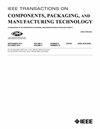Enhanced Design of Airborne Radiation Sensor for Improved Survivability During Deployment Impact
IF 3
3区 工程技术
Q2 ENGINEERING, ELECTRICAL & ELECTRONIC
IEEE Transactions on Components, Packaging and Manufacturing Technology
Pub Date : 2025-04-22
DOI:10.1109/TCPMT.2025.3563253
引用次数: 0
Abstract
By employing optimized outer packaging designs and materials, the impact energy can be effectively absorbed or dissipated, thereby preventing potential damage to interconnections and chips. This includes mitigating solder-joint fractures, chip cracks, pad cratering or lifting, and other mechanical stresses that commonly result from impact forces. To ensure that the internal ionic sensor remains resilient to moisture intrusion and can endure impact velocities of up to 30 mph, advanced packaging solutions have been developed. In this study, the ANSYS/LS-DYNA finite element analysis (FEAs) tool was utilized to evaluate the performance of various packaging designs in minimizing the shock energy transferred to the printed circuit board (PCB). Modifications were made to the external foam packaging to increase the effective thickness and stiffness of the PCB, thus limiting its deformation under impact. These adjustments involved testing several configurations, including a two-layer foam system, a single-layer foam, and variations in the foam material’s stress-strain characteristics. The results demonstrated a significant reduction in PCB deformation—by 86.9%—with the final design achieving a deformation of just提高机载辐射传感器在部署冲击中的生存能力的改进设计
通过采用优化的外包装设计和材料,可以有效地吸收或消散冲击能量,从而防止对互连和芯片的潜在损坏。这包括减轻焊点断裂、切屑裂纹、焊盘凹坑或提升,以及其他通常由冲击力引起的机械应力。为了确保内部离子传感器对水分侵入保持弹性,并能承受高达30英里/小时的冲击速度,先进的封装解决方案已经开发出来。在本研究中,利用ANSYS/LS-DYNA有限元分析(FEAs)工具来评估各种封装设计在最大限度地减少传递到印刷电路板(PCB)的冲击能量方面的性能。对外泡沫封装进行了修改,增加了PCB的有效厚度和刚度,从而限制了PCB在冲击下的变形。这些调整涉及测试几种配置,包括两层泡沫系统,单层泡沫,以及泡沫材料应力-应变特性的变化。结果表明,PCB变形显著减少了86.9%,最终设计的变形仅为52美元~\mu $ m,而初始设计的变形为398.7美元~\mu $ m。此外,针对不同的液滴方向对最终设计进行了仿真,以确保无论液滴方向如何,面外变形都保持在同一数量级。
本文章由计算机程序翻译,如有差异,请以英文原文为准。
求助全文
约1分钟内获得全文
求助全文
来源期刊

IEEE Transactions on Components, Packaging and Manufacturing Technology
ENGINEERING, MANUFACTURING-ENGINEERING, ELECTRICAL & ELECTRONIC
CiteScore
4.70
自引率
13.60%
发文量
203
审稿时长
3 months
期刊介绍:
IEEE Transactions on Components, Packaging, and Manufacturing Technology publishes research and application articles on modeling, design, building blocks, technical infrastructure, and analysis underpinning electronic, photonic and MEMS packaging, in addition to new developments in passive components, electrical contacts and connectors, thermal management, and device reliability; as well as the manufacture of electronics parts and assemblies, with broad coverage of design, factory modeling, assembly methods, quality, product robustness, and design-for-environment.
 求助内容:
求助内容: 应助结果提醒方式:
应助结果提醒方式:


